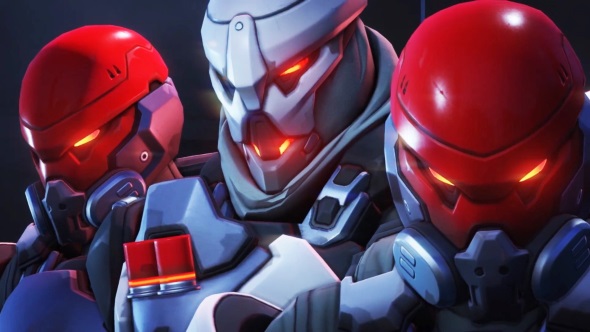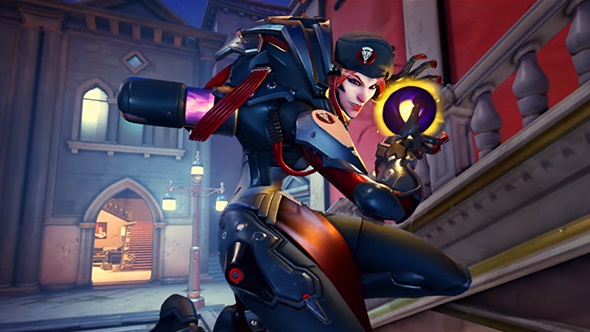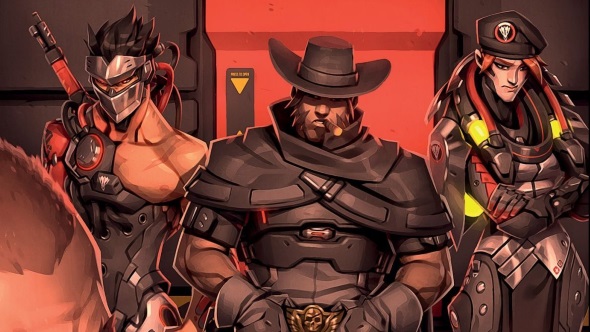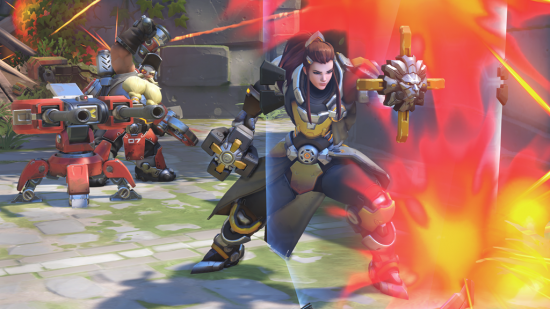Overwatch Retribution, the new PvE event and second of the Overwatch Archives missions, goes live today. In advance of the event, we were invited to a roundtable Q&A session with game director Jeff Kaplan and principal software engineer Adrian Finol. The pair offered insights into Retribution’s development and enemies, the long-running challenge of balance, and if we can expect PvE to become a permanent mode in Overwatch.
Take a look at everything included in the Overwatch Retribution PvE event.
PCGN: How long has Retribution been in development?
Jeff Kaplan: Because we’re set up as a PvP team, making PvE content is difficult for us and very time consuming. We began work on Retribution in May last year. If you remember, Uprising was released in April of last year. We basically ran the Uprising event, we finished it out, we did a bunch of post-morteming – talking about what we really loved and didn’t love about Uprising – and almost started work immediately on Retribution.
Overwatch is built on a proprietary game engine called Tank, and I think it’s one of the reasons Overwatch feels so great. We’ve spent a lot of time optimising that engine for a 6v6 action shooter. It wasn’t built to make PvE, and a lot of what we’ve done with Junkenstein, Uprising, and Retribution is building a lot of core technology and doing a lot of optimisations to allow us to do more PvE stuff.
Why did you choose this particular story for Retribution?
Jeff Kaplan: It was also a lot of fun picking an event in Overwatch history. Which event do we really think would be cool and meaningful? This one we chose for a number of reasons. We think it’s really important to show that Gabriel Reyes/Reaper is a much deeper character than people realise.
I think in some of the animated shorts he’s come across as a little bit one-sided, but we want people to see that there’s a lot more to him and understand how he gets to that place. I think we also wanted to start to show more about Talon, and have our players realise what the Talon organisation is all about. How is it structured, and what types of individuals, and what types of motives does Talon have? Those were some of the thoughts that went in and the effort that went into making Retribution.

How do the special enemy units in Retribution work?
Jeff Kaplan: The assassin is a lot of fun. When the assassin comes into the scene you’ll know that she’s there. Your squadmates will make comments about it – they all have VO and they’ll say ‘I think there’s an assassin nearby’. [The assassin] has this really fun mechanic where she can perch on walls, but she moves very very quickly, and she’ll bounce around onto different walls around the squad.
If you’re a really talented marksman and you have the ability to shoot her fast enough, you can kill her before the group is under any threat whatsoever. If not, she goes into this mode where she really peruses a single person on your squad and pins them down. You need to do enough damage to her before she gets up. There are all sorts of interesting mechanics you can do as players to deal with this, especially in All Heroes mode. Sometimes we’ll play Torbjorn and Symmetra and we’ll build a turret nest around the squad and then tell everyone to stand near the turret, so that way when the assassins come to get us the turret really saves us from them.
The sniper is also really interesting because you know where she is at all times. She has a giant beam that shows you where she’s aiming so you can really predict how to get out of trouble. But the fun point about the sniper is, if you do too much damage to her, or she feels like she’s in a bad location, she can use a grapple hook similar to the one Widowmaker has and get into all sorts of unique locations in the map. So you’re making these really cool choices, especially because you’re playing heroes like Genji, or Gabriel Reyes who can do the Reaper teleport. You’re deciding ‘Should I use my movement ability now to get to the sniper, or should I hold it off because she might change location and then I won’t be able to get to her?’. There’s a lot of new and interesting gameplay that comes about because of these new units.
Why do the same events recur each year?
Jeff Kaplan: We designed the seasonal events to be recurring because we thought it was a very fun thing for players to get to experience at various points in the year. We think it’s very cool that when it’s winter time in the northern hemisphere Winter Wonderland is going on. Halloween is a very particular time of year and we tie our event to that.
Another reason why we like recurring events is because Overwatch gains a lot of players every single week and month. There are so many players who are very excited and say to us ‘Oh wow, I can’t wait for Summer Games, I’ve never gotten to experience it before’. As you know, there’s a lot of cool cosmetic items and events such as Lucioball that only exist during those times, and it’s a chance for newer players to experience content they’ve never seen before.
We also think that the seasonal events are a great way to break up the routine that players create for themselves. It’s very easy for us to say ‘I’m just a comp player. All I do is play comp’, and then play so much competitive that I start to feel almost fatigued by it. We think that the seasonal events are a good way to, in a very friendly and healthy manner, encourage players to go ‘Hey, there’s cool new stuff, it’s only here for a short time. Why don’t you take a break from your normal Overwatch routine and experience something new ?’.
We’ve added fun, compelling new stuff to all the seasonal events each time, so they’re all a little bit different. We really love making new stuff too, and we love making the new heroes and the new maps, so we hope that those feel like experiences that shake up the normal routine for players. We also love making features, releasing stuff like Custom Games or saving highlights or the Arcade, or all of the work we did to make Overwatch League a big moment for our players. All of this is exciting to us, and what we’re trying to do is almost make Overwatch feel like an experience where you don’t know what each month is going to bring. Whether or not we add a new seasonal event, I think that’s really fun and exciting to think about, and I think it’s a project the team would be excited to tackle.

What was it like creating a new map that was both PvP and PvE?
Adrian Finol: Rialto was really fun to work on. It was interesting to find a knife balance between PvE and PvP. We thought it would be interesting to play a map that is shared between those two game modes. It was also really fun to work on a day time and a nighttime map at the same time. We think our audience is going to love seeing it. Most maps you only see during one time – Dorado is always at night. But you play Retribution at night and you can go play Rialto during the day time [in PvP]. It’s been really fun playing it as a Payload map. You can also tell it’s a little bit different, like the timeline is a little further in the future.
Will PvE modes like Uprising and Retribution ever be made permanent features?
Jeff Kaplan: We thought a lot about the PvE events and it’s very flattering to us that players want them to stick around for longer than the event length. One concern that we have, as fun and as replayable we think Retribution is, we have some concerns that leaving it available for the entire year may be somewhat fatiguing for players.
We think it adds a tremendous amount of value and replayability for a short period of time, but as many of us on the Overwatch team have worked on extensively PvE games, in our experience players can be very veracious for more. As fun as Retribution is for a few weeks, there may be a desire for us to do a lot more with it that we don’t have immediate plans to do. So we really want to prevent players from feeling fatigued from it, or feeling like the event isn’t cool enough. For us it’s like this special moment that should be celebrated for a few weeks.
However, I would never say never. I once said never to Deathmatch being in the game, and it turns out Deathmatch was one of the funnest modes we’ve ever had. So I would never say never. But before making Retribution and Uprising available for more time during the year we’d have to think about more ways of managing players expectations in the fact that, while they’re super fun and super cool events, they are pretty small and they’re not far-reaching. They don’t have the breadth of content that we’d normally like for a complete PvE experience.

Will we ever see the Cape Town incident mentioned in the Retribution comic?
Jeff Kaplan: One of the things that really means a lot to us in Overwatch is that it’s this global game. We like to think of the world – planet Earth – as one of the most exciting places that exists. That’s coming from a company that likes to make these awesome fantasy and sci-fi universes, but we find planet Earth endlessly compelling. We hope to explore all reaches of the planet.
Obviously, Africa is very exciting to us. You’ve seen it in Numbani to Doomfist to Orisa, and we want to expand much more. One of the things we do frequently in our lore is put out seeds of content that we’d like to explore in the future. We mention things. I’m not sure if people picked up on this but when we released Moira, but we mentioned something called the Venice Incident, and that actually is Retribution. So I hope that’s a good example and gives you some hope that we hope to explore what did happen in Cape Town. That is something we could make into a piece, either fiction or gameplay, that we explore at a future time. We would love to do that.
Will Archives push the Overwatch timeline forward?
Jeff Kaplan: We’ve just finished Retribution right now and I think the team’s plan is to see how Retribution goes and then really listen to the community to see what our players are saying. That will probably inform what we do in the future. We hear a lot of desire from people to move the storyline forward so that’s feedback that we’re listening to closely.
And what are your plans for advancing Overwatch’s lore?
Jeff Kaplan: The team loves building a universe and we love exploring different mediums. There are more comics coming – that’s something very exciting to us. We have an amazingly talented animation group that loves making the animated shorts in collaboration with the Overwatch team, so we will make more of those. It’s a really fun place for us to be in, to think about what other mediums are out there that we’re not using right now. What could we be doing to explore Overwatch from a lore and story perspective, and possibly in a bigger, better sort of way? We’re really brainstorming in a lot of different directions. There’s a lot of activity to make that happen. I don’t have anything in particular to talk about at this time, but it’s at the forefront of our mind.

How satisfied are you with the current balance of Overwatch?
Jeff Kaplan: I’d say we’re never completely satisfied with where the balance is. Balance is an ongoing effort for us, and we’re constantly looking at all 27 heroes and how they’re netting out at the end of the day.
I think our constant efforts are actually best exemplified with Doomfist and Sombra, in the fact that their win rates are not completely where it needs to be right now. But the amount of effort we’ve put into Doomfist lately has been very significant. The same goes for Sombra: we’re trying to make changes. We’re just trying to be responsible in the changes that we make to not swing them too far the other way. It’s very easy for us to overpower a hero, and in particular with Doomfist and Sombra they each have separate mechanics that can be very oppressive to other players if we’re not careful with them.
In Sombra’s case, the hack is a very powerful ability that completely removes another player’s ability to do their cool things. So we have to be very metered in how we balance her so she doesn’t overwhelm people or make the game unfun. And the same with Doomfist. It’s mostly Rocket Punch that we have to be really careful with, because as you know, if I line [an enemy] up against the wall and hit them it’s a one-shot kill. Anytime we have those one-shot kills we really want to be careful to make sure they feel fair, balanced, and like there was some counterplay on the other side.
So I definitely agree that Sombra and Doomfist are not 100% where they need to be, but I hope that our recent efforts against them show we haven’t forgotten about them and that we’re going to continue to iterate on all the heroes until we feel like balance is in a good spot. And even then we’ll continue to iterate because balance is ongoing.
Will characters ever be balanced independently for different game modes?
Jeff Kaplan: We’re actually talking about this. We want to be careful about balancing heroes for different modes. We think it is not the right decision for the game. We want players to be able to move fluidly between modes and not have the heroes feel drastically different from one mode to another.
That was something we had a pretty heated debate on. We also need to be careful on balancing the game around Deathmatch specifically because, at its core, Deathmatch is not in our competitive mode. It’s not what we would consider a core game mode. So we need to be careful to protect those core game modes to make sure the balance of the game is correct.
In some ways, Deathmatch, especially free-for-all, is very self-balancing in the fact that if a character that you perceive is underpowered, our answer is usually ‘just don’t play that one in that mode’. But hopefully they are viable in the other mode. It would be a big mistake if we ever felt like a character was not viable in any mode in the game and that would be very upsetting to us. But as we add more game modes like Capture the Flag, Deathmatch, our 1v1 Duels, our Elimination modes, we have to be a little bit open to the fact that not every hero is going to be as viable as every other one. It’s the price we pay for adding more game modes in a game that already has so many heroes. Our core hero balance is always set around the core game modes – Quick Play and Competitive play – and then we really try our best to make sure things just aren’t broken in the other modes.
Will players ever be able to share progress between console and PC?
Jeff Kaplan: This is something that we have ongoing and frequent discussions about with our tech group. It’s something we would very like to explore. It’s very challenging for many reasons, and I won’t get into all the details as to why, but I think it’s a very valid desire that our players have and it’s something that the Overwatch team would love to figure out. We will continue to work hard on it to make it happen someday, if we can get around some of the challenges that we’re faced with.
Overwatch Retribution goes live today, and runs until April 30. Want more? Check out our Overwatch hub page for more news from Blizzard’s hero shooter.
